Organizational Structure and Knowledge Management for Desklib
VerifiedAdded on 2023/05/28
|7
|2100
|53
AI Summary
This article discusses the hierarchical arrangement of authority, communication, and rights in the organizational structure of Desklib. It also emphasizes the importance of knowledge management for protecting confidential information and intellectual property rights.
Contribute Materials
Your contribution can guide someone’s learning journey. Share your
documents today.
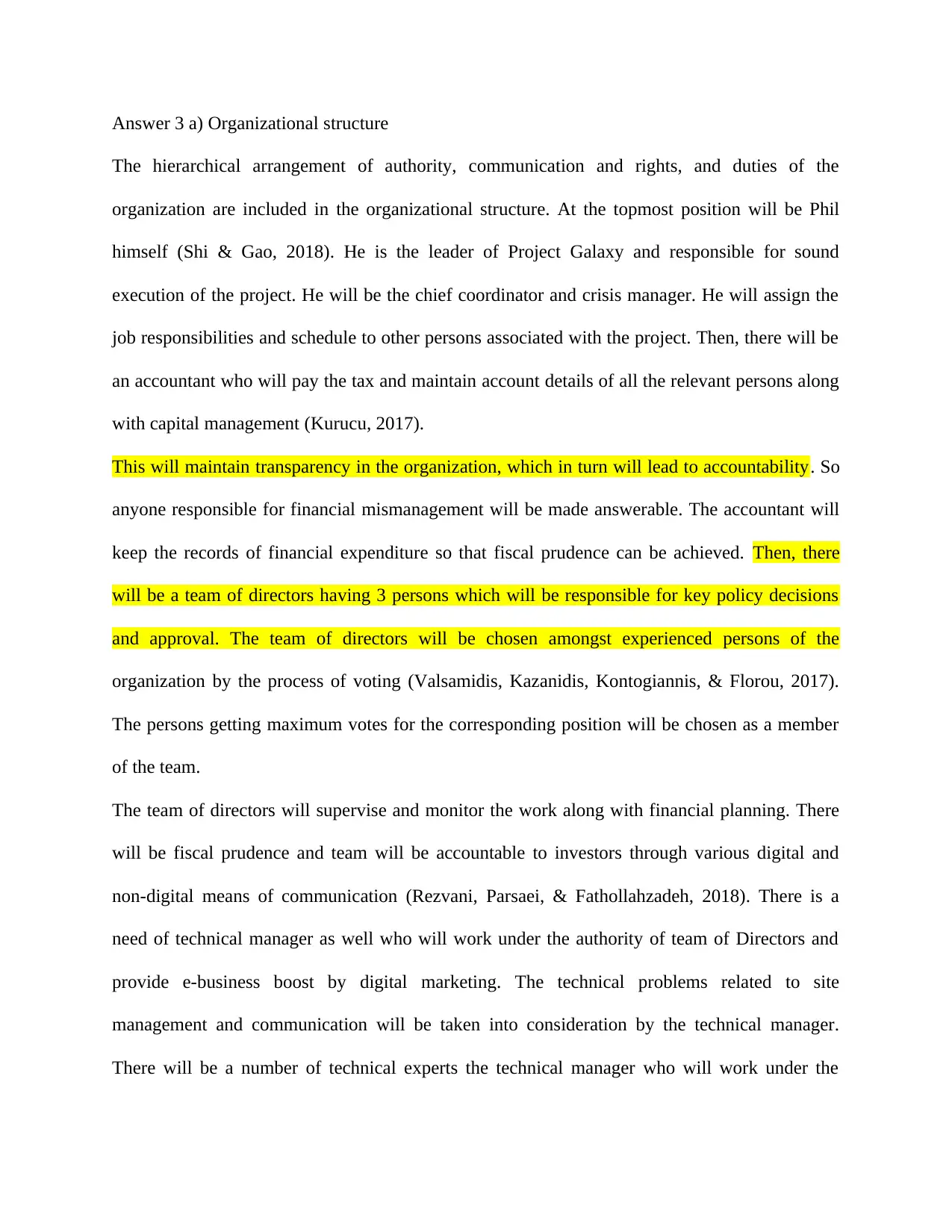
Answer 3 a) Organizational structure
The hierarchical arrangement of authority, communication and rights, and duties of the
organization are included in the organizational structure. At the topmost position will be Phil
himself (Shi & Gao, 2018). He is the leader of Project Galaxy and responsible for sound
execution of the project. He will be the chief coordinator and crisis manager. He will assign the
job responsibilities and schedule to other persons associated with the project. Then, there will be
an accountant who will pay the tax and maintain account details of all the relevant persons along
with capital management (Kurucu, 2017).
This will maintain transparency in the organization, which in turn will lead to accountability. So
anyone responsible for financial mismanagement will be made answerable. The accountant will
keep the records of financial expenditure so that fiscal prudence can be achieved. Then, there
will be a team of directors having 3 persons which will be responsible for key policy decisions
and approval. The team of directors will be chosen amongst experienced persons of the
organization by the process of voting (Valsamidis, Kazanidis, Kontogiannis, & Florou, 2017).
The persons getting maximum votes for the corresponding position will be chosen as a member
of the team.
The team of directors will supervise and monitor the work along with financial planning. There
will be fiscal prudence and team will be accountable to investors through various digital and
non-digital means of communication (Rezvani, Parsaei, & Fathollahzadeh, 2018). There is a
need of technical manager as well who will work under the authority of team of Directors and
provide e-business boost by digital marketing. The technical problems related to site
management and communication will be taken into consideration by the technical manager.
There will be a number of technical experts the technical manager who will work under the
The hierarchical arrangement of authority, communication and rights, and duties of the
organization are included in the organizational structure. At the topmost position will be Phil
himself (Shi & Gao, 2018). He is the leader of Project Galaxy and responsible for sound
execution of the project. He will be the chief coordinator and crisis manager. He will assign the
job responsibilities and schedule to other persons associated with the project. Then, there will be
an accountant who will pay the tax and maintain account details of all the relevant persons along
with capital management (Kurucu, 2017).
This will maintain transparency in the organization, which in turn will lead to accountability. So
anyone responsible for financial mismanagement will be made answerable. The accountant will
keep the records of financial expenditure so that fiscal prudence can be achieved. Then, there
will be a team of directors having 3 persons which will be responsible for key policy decisions
and approval. The team of directors will be chosen amongst experienced persons of the
organization by the process of voting (Valsamidis, Kazanidis, Kontogiannis, & Florou, 2017).
The persons getting maximum votes for the corresponding position will be chosen as a member
of the team.
The team of directors will supervise and monitor the work along with financial planning. There
will be fiscal prudence and team will be accountable to investors through various digital and
non-digital means of communication (Rezvani, Parsaei, & Fathollahzadeh, 2018). There is a
need of technical manager as well who will work under the authority of team of Directors and
provide e-business boost by digital marketing. The technical problems related to site
management and communication will be taken into consideration by the technical manager.
There will be a number of technical experts the technical manager who will work under the
Secure Best Marks with AI Grader
Need help grading? Try our AI Grader for instant feedback on your assignments.
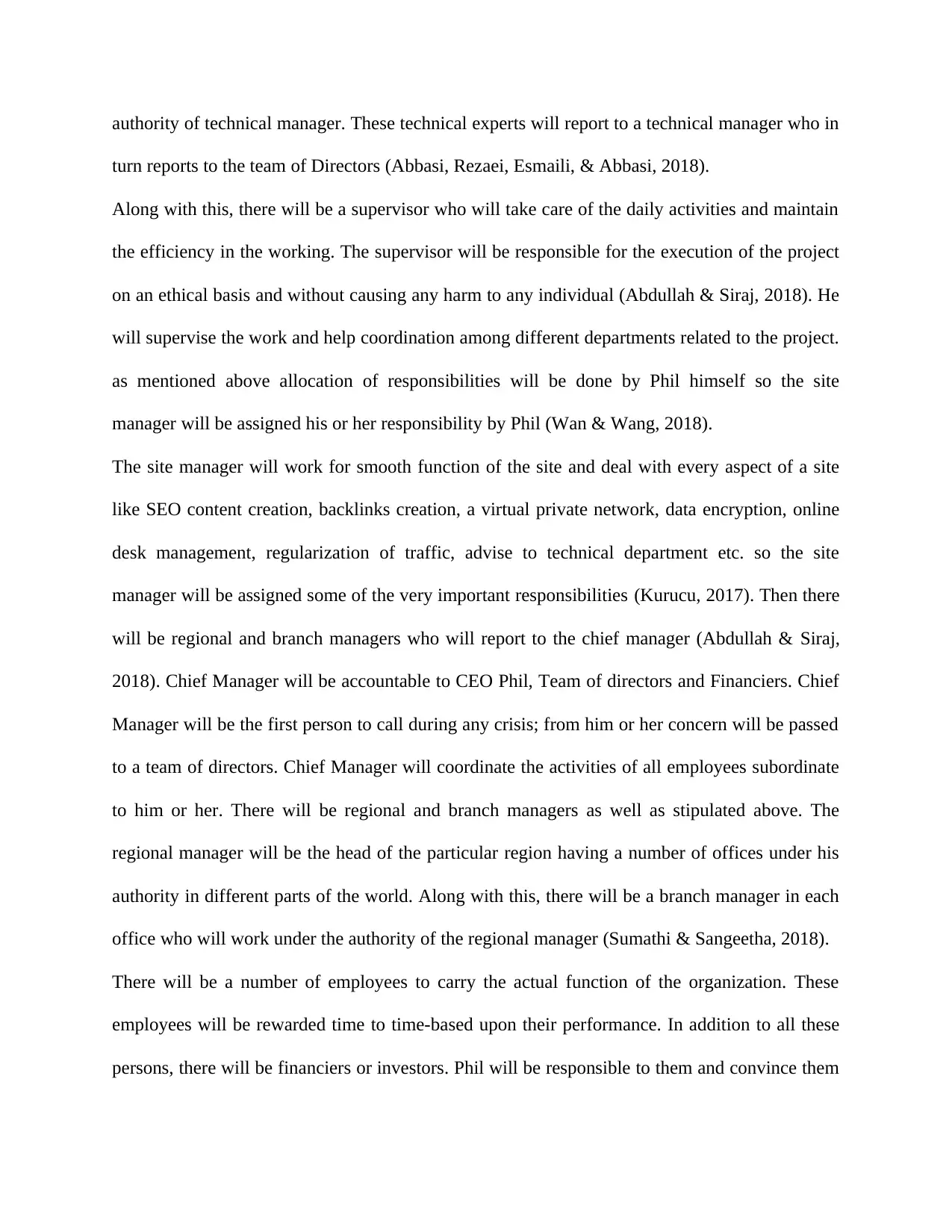
authority of technical manager. These technical experts will report to a technical manager who in
turn reports to the team of Directors (Abbasi, Rezaei, Esmaili, & Abbasi, 2018).
Along with this, there will be a supervisor who will take care of the daily activities and maintain
the efficiency in the working. The supervisor will be responsible for the execution of the project
on an ethical basis and without causing any harm to any individual (Abdullah & Siraj, 2018). He
will supervise the work and help coordination among different departments related to the project.
as mentioned above allocation of responsibilities will be done by Phil himself so the site
manager will be assigned his or her responsibility by Phil (Wan & Wang, 2018).
The site manager will work for smooth function of the site and deal with every aspect of a site
like SEO content creation, backlinks creation, a virtual private network, data encryption, online
desk management, regularization of traffic, advise to technical department etc. so the site
manager will be assigned some of the very important responsibilities (Kurucu, 2017). Then there
will be regional and branch managers who will report to the chief manager (Abdullah & Siraj,
2018). Chief Manager will be accountable to CEO Phil, Team of directors and Financiers. Chief
Manager will be the first person to call during any crisis; from him or her concern will be passed
to a team of directors. Chief Manager will coordinate the activities of all employees subordinate
to him or her. There will be regional and branch managers as well as stipulated above. The
regional manager will be the head of the particular region having a number of offices under his
authority in different parts of the world. Along with this, there will be a branch manager in each
office who will work under the authority of the regional manager (Sumathi & Sangeetha, 2018).
There will be a number of employees to carry the actual function of the organization. These
employees will be rewarded time to time-based upon their performance. In addition to all these
persons, there will be financiers or investors. Phil will be responsible to them and convince them
turn reports to the team of Directors (Abbasi, Rezaei, Esmaili, & Abbasi, 2018).
Along with this, there will be a supervisor who will take care of the daily activities and maintain
the efficiency in the working. The supervisor will be responsible for the execution of the project
on an ethical basis and without causing any harm to any individual (Abdullah & Siraj, 2018). He
will supervise the work and help coordination among different departments related to the project.
as mentioned above allocation of responsibilities will be done by Phil himself so the site
manager will be assigned his or her responsibility by Phil (Wan & Wang, 2018).
The site manager will work for smooth function of the site and deal with every aspect of a site
like SEO content creation, backlinks creation, a virtual private network, data encryption, online
desk management, regularization of traffic, advise to technical department etc. so the site
manager will be assigned some of the very important responsibilities (Kurucu, 2017). Then there
will be regional and branch managers who will report to the chief manager (Abdullah & Siraj,
2018). Chief Manager will be accountable to CEO Phil, Team of directors and Financiers. Chief
Manager will be the first person to call during any crisis; from him or her concern will be passed
to a team of directors. Chief Manager will coordinate the activities of all employees subordinate
to him or her. There will be regional and branch managers as well as stipulated above. The
regional manager will be the head of the particular region having a number of offices under his
authority in different parts of the world. Along with this, there will be a branch manager in each
office who will work under the authority of the regional manager (Sumathi & Sangeetha, 2018).
There will be a number of employees to carry the actual function of the organization. These
employees will be rewarded time to time-based upon their performance. In addition to all these
persons, there will be financiers or investors. Phil will be responsible to them and convince them

whenever the need arises. there will be regular meetings of financiers, Phil, and the team of
Directors (Shi & Gao, 2018). There will be an online grievance redressal officer who will take
concerns from the customer and solve their problem. There will be a custom relationship
manager as well who will deal directly with customers like delivery of the products and services
to the customer, feedback from customers, the first port of call, live chat functions, email
promotion etc.
There will be sound management of the project by all these individuals. There will be a talent
and resource acquisition manager who will recruit the employees on the basis of merit and
ensures that diversity is maintained in the organization (Sumathi & Sangeetha, 2018). There will
be an effective implementation strategy to deal with contingencies. The hierarchy has been set up
to take appropriate reaction during the time of contingency according to the gravity of the matter.
These persons will ensure sound operational management, supervision, monitoring, functioning
etc.
Answer 3 b) knowledge management
The hierarchical set up has been discussed in the above segment of the paper. There is
continuous flow of confidential information so there is a need for a proper knowledge
management strategy (Abbasi, Rezaei, Esmaili, & Abbasi, 2018). To prevent the leakage of
confidential information and loss of intellectual property rights, knowledge management will be
done taking the importance of transparency in mind. There will be adequate protection of
customers’ data as well. This information must be stored with utmost care as it will involve even
the bank account details of the customers.
Directors (Shi & Gao, 2018). There will be an online grievance redressal officer who will take
concerns from the customer and solve their problem. There will be a custom relationship
manager as well who will deal directly with customers like delivery of the products and services
to the customer, feedback from customers, the first port of call, live chat functions, email
promotion etc.
There will be sound management of the project by all these individuals. There will be a talent
and resource acquisition manager who will recruit the employees on the basis of merit and
ensures that diversity is maintained in the organization (Sumathi & Sangeetha, 2018). There will
be an effective implementation strategy to deal with contingencies. The hierarchy has been set up
to take appropriate reaction during the time of contingency according to the gravity of the matter.
These persons will ensure sound operational management, supervision, monitoring, functioning
etc.
Answer 3 b) knowledge management
The hierarchical set up has been discussed in the above segment of the paper. There is
continuous flow of confidential information so there is a need for a proper knowledge
management strategy (Abbasi, Rezaei, Esmaili, & Abbasi, 2018). To prevent the leakage of
confidential information and loss of intellectual property rights, knowledge management will be
done taking the importance of transparency in mind. There will be adequate protection of
customers’ data as well. This information must be stored with utmost care as it will involve even
the bank account details of the customers.
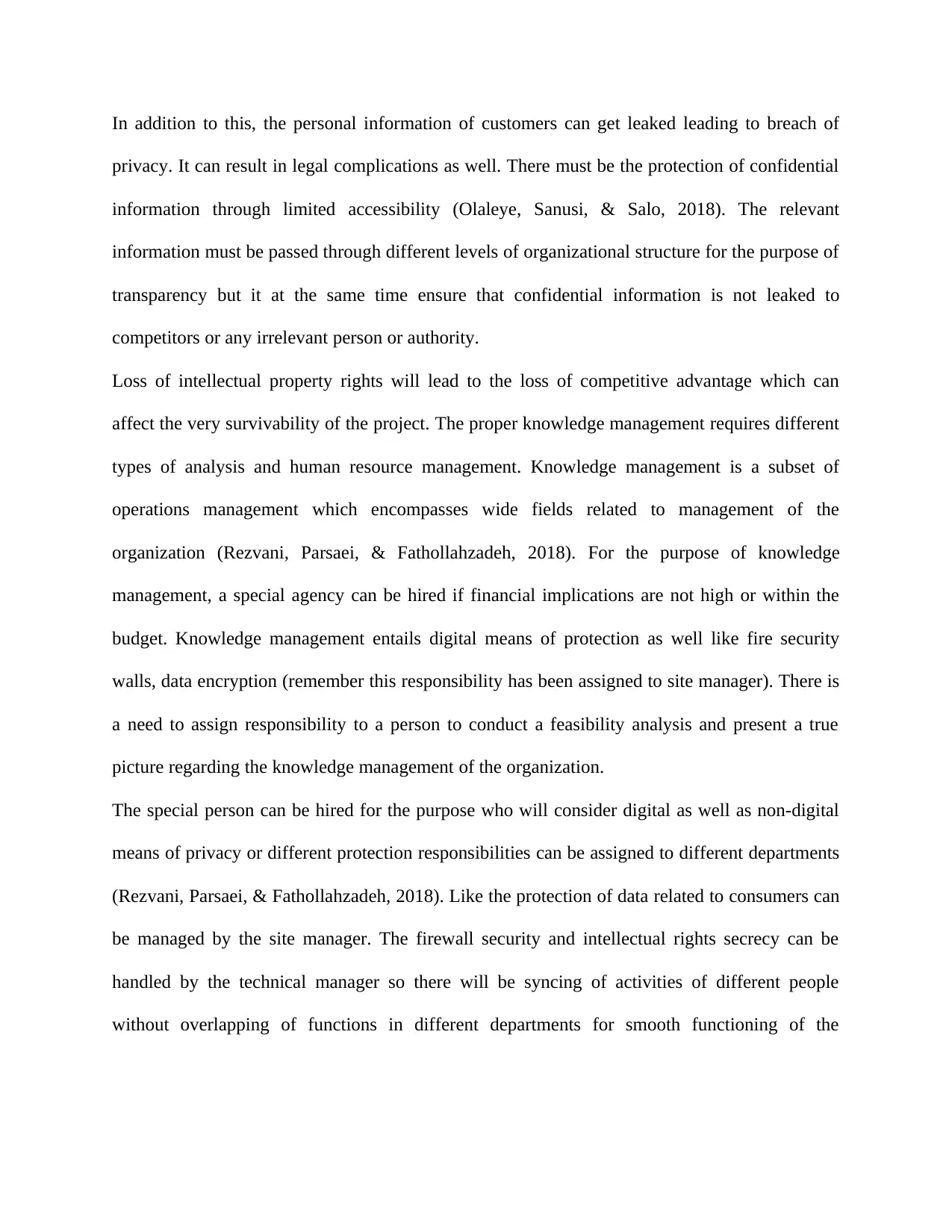
In addition to this, the personal information of customers can get leaked leading to breach of
privacy. It can result in legal complications as well. There must be the protection of confidential
information through limited accessibility (Olaleye, Sanusi, & Salo, 2018). The relevant
information must be passed through different levels of organizational structure for the purpose of
transparency but it at the same time ensure that confidential information is not leaked to
competitors or any irrelevant person or authority.
Loss of intellectual property rights will lead to the loss of competitive advantage which can
affect the very survivability of the project. The proper knowledge management requires different
types of analysis and human resource management. Knowledge management is a subset of
operations management which encompasses wide fields related to management of the
organization (Rezvani, Parsaei, & Fathollahzadeh, 2018). For the purpose of knowledge
management, a special agency can be hired if financial implications are not high or within the
budget. Knowledge management entails digital means of protection as well like fire security
walls, data encryption (remember this responsibility has been assigned to site manager). There is
a need to assign responsibility to a person to conduct a feasibility analysis and present a true
picture regarding the knowledge management of the organization.
The special person can be hired for the purpose who will consider digital as well as non-digital
means of privacy or different protection responsibilities can be assigned to different departments
(Rezvani, Parsaei, & Fathollahzadeh, 2018). Like the protection of data related to consumers can
be managed by the site manager. The firewall security and intellectual rights secrecy can be
handled by the technical manager so there will be syncing of activities of different people
without overlapping of functions in different departments for smooth functioning of the
privacy. It can result in legal complications as well. There must be the protection of confidential
information through limited accessibility (Olaleye, Sanusi, & Salo, 2018). The relevant
information must be passed through different levels of organizational structure for the purpose of
transparency but it at the same time ensure that confidential information is not leaked to
competitors or any irrelevant person or authority.
Loss of intellectual property rights will lead to the loss of competitive advantage which can
affect the very survivability of the project. The proper knowledge management requires different
types of analysis and human resource management. Knowledge management is a subset of
operations management which encompasses wide fields related to management of the
organization (Rezvani, Parsaei, & Fathollahzadeh, 2018). For the purpose of knowledge
management, a special agency can be hired if financial implications are not high or within the
budget. Knowledge management entails digital means of protection as well like fire security
walls, data encryption (remember this responsibility has been assigned to site manager). There is
a need to assign responsibility to a person to conduct a feasibility analysis and present a true
picture regarding the knowledge management of the organization.
The special person can be hired for the purpose who will consider digital as well as non-digital
means of privacy or different protection responsibilities can be assigned to different departments
(Rezvani, Parsaei, & Fathollahzadeh, 2018). Like the protection of data related to consumers can
be managed by the site manager. The firewall security and intellectual rights secrecy can be
handled by the technical manager so there will be syncing of activities of different people
without overlapping of functions in different departments for smooth functioning of the
Paraphrase This Document
Need a fresh take? Get an instant paraphrase of this document with our AI Paraphraser
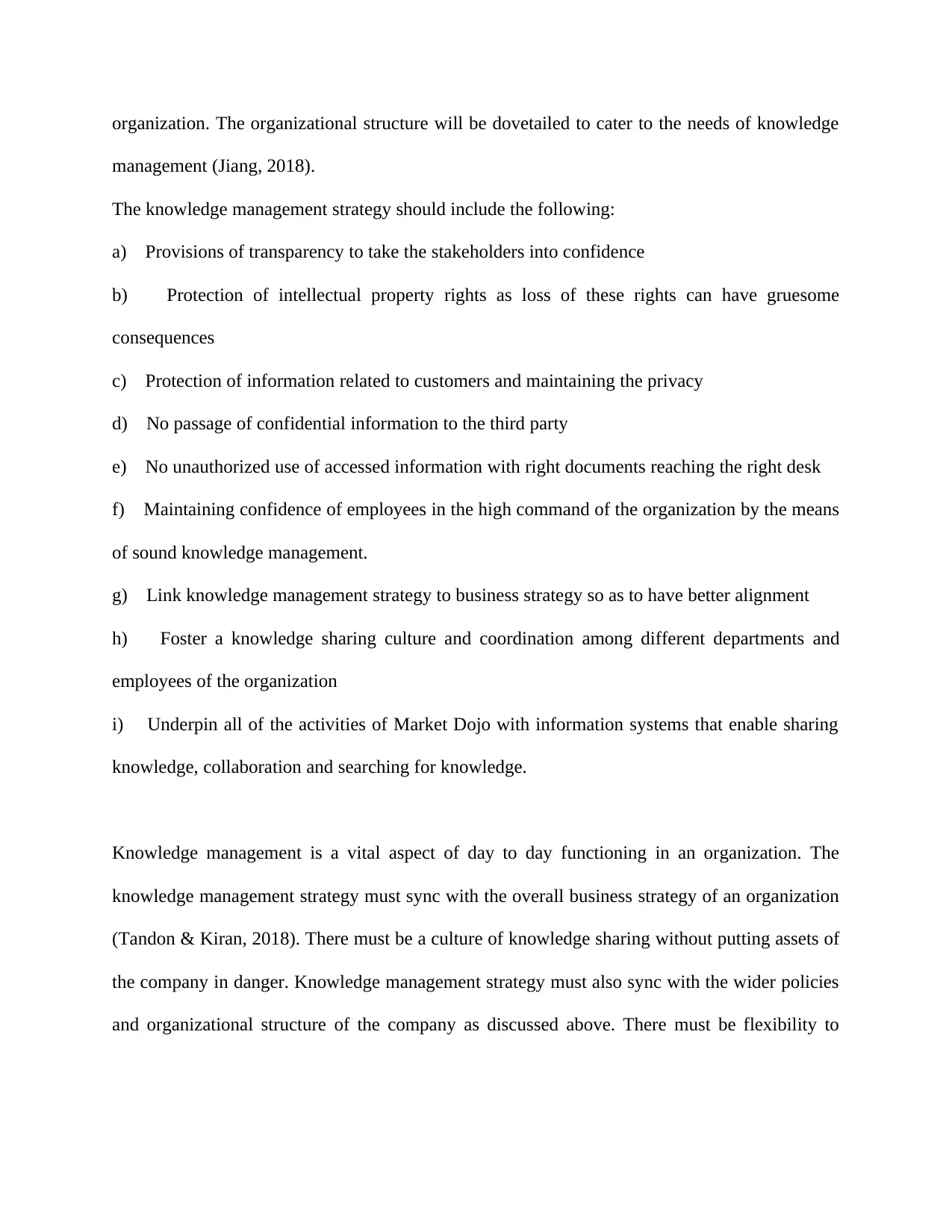
organization. The organizational structure will be dovetailed to cater to the needs of knowledge
management (Jiang, 2018).
The knowledge management strategy should include the following:
a) Provisions of transparency to take the stakeholders into confidence
b) Protection of intellectual property rights as loss of these rights can have gruesome
consequences
c) Protection of information related to customers and maintaining the privacy
d) No passage of confidential information to the third party
e) No unauthorized use of accessed information with right documents reaching the right desk
f) Maintaining confidence of employees in the high command of the organization by the means
of sound knowledge management.
g) Link knowledge management strategy to business strategy so as to have better alignment
h) Foster a knowledge sharing culture and coordination among different departments and
employees of the organization
i) Underpin all of the activities of Market Dojo with information systems that enable sharing
knowledge, collaboration and searching for knowledge.
Knowledge management is a vital aspect of day to day functioning in an organization. The
knowledge management strategy must sync with the overall business strategy of an organization
(Tandon & Kiran, 2018). There must be a culture of knowledge sharing without putting assets of
the company in danger. Knowledge management strategy must also sync with the wider policies
and organizational structure of the company as discussed above. There must be flexibility to
management (Jiang, 2018).
The knowledge management strategy should include the following:
a) Provisions of transparency to take the stakeholders into confidence
b) Protection of intellectual property rights as loss of these rights can have gruesome
consequences
c) Protection of information related to customers and maintaining the privacy
d) No passage of confidential information to the third party
e) No unauthorized use of accessed information with right documents reaching the right desk
f) Maintaining confidence of employees in the high command of the organization by the means
of sound knowledge management.
g) Link knowledge management strategy to business strategy so as to have better alignment
h) Foster a knowledge sharing culture and coordination among different departments and
employees of the organization
i) Underpin all of the activities of Market Dojo with information systems that enable sharing
knowledge, collaboration and searching for knowledge.
Knowledge management is a vital aspect of day to day functioning in an organization. The
knowledge management strategy must sync with the overall business strategy of an organization
(Tandon & Kiran, 2018). There must be a culture of knowledge sharing without putting assets of
the company in danger. Knowledge management strategy must also sync with the wider policies
and organizational structure of the company as discussed above. There must be flexibility to
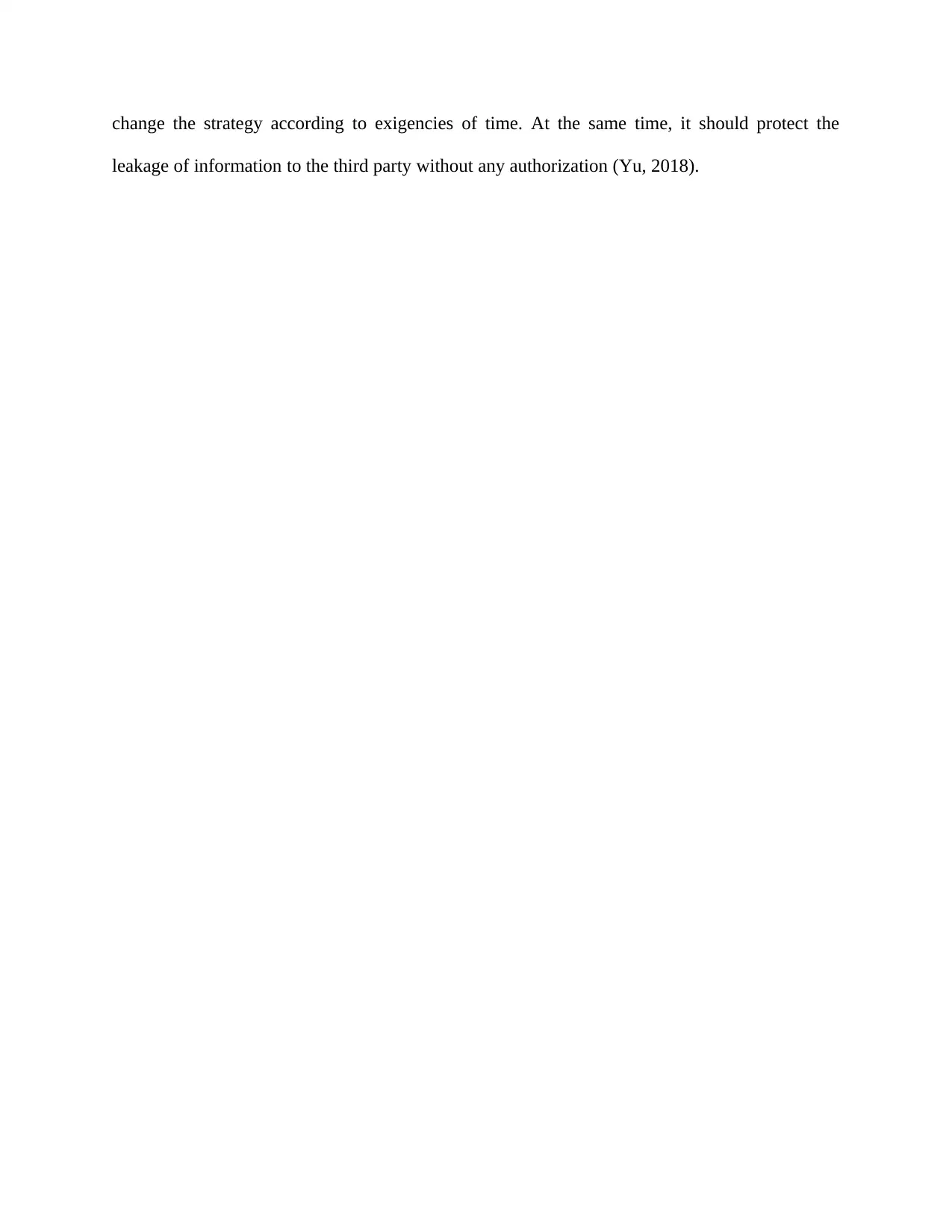
change the strategy according to exigencies of time. At the same time, it should protect the
leakage of information to the third party without any authorization (Yu, 2018).
leakage of information to the third party without any authorization (Yu, 2018).
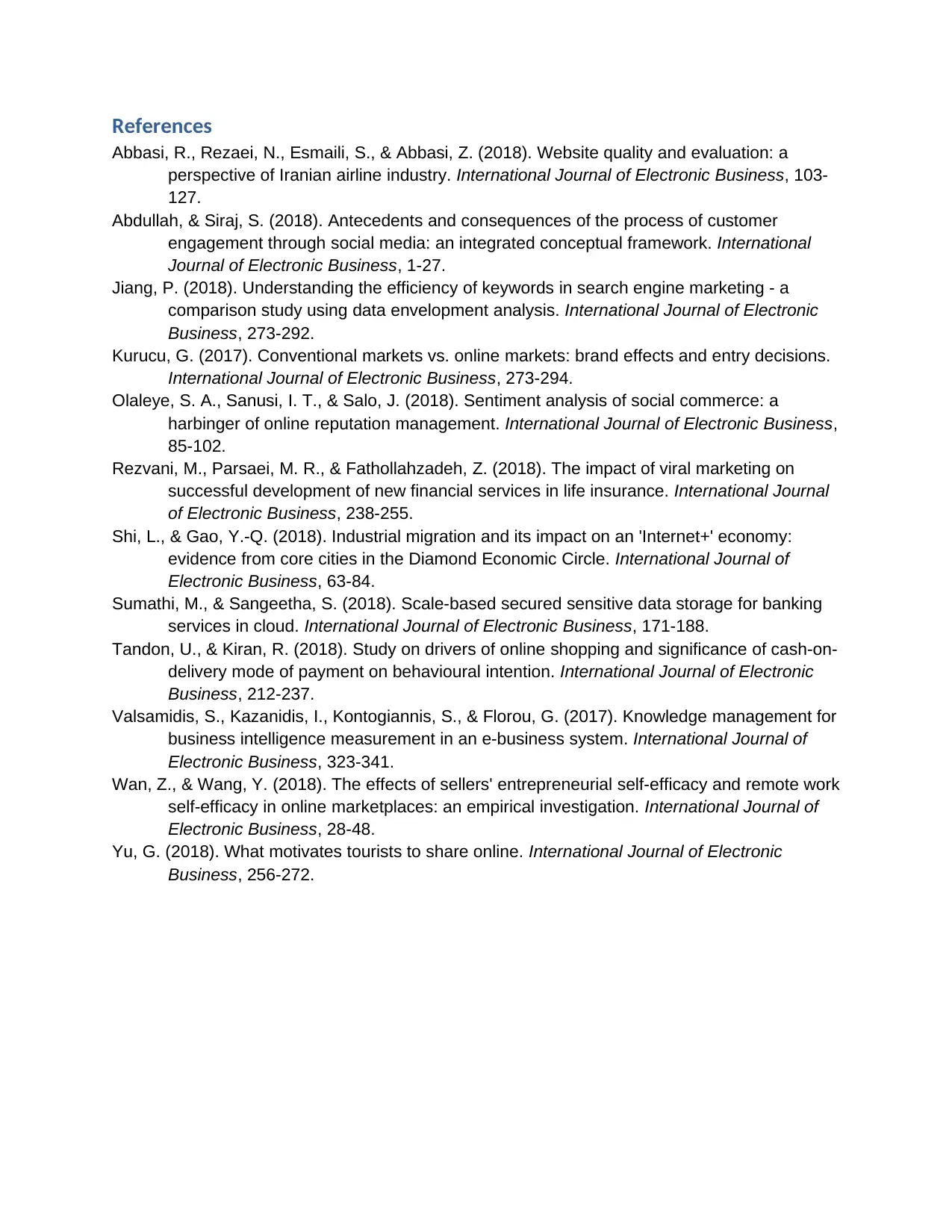
References
Abbasi, R., Rezaei, N., Esmaili, S., & Abbasi, Z. (2018). Website quality and evaluation: a
perspective of Iranian airline industry. International Journal of Electronic Business, 103-
127.
Abdullah, & Siraj, S. (2018). Antecedents and consequences of the process of customer
engagement through social media: an integrated conceptual framework. International
Journal of Electronic Business, 1-27.
Jiang, P. (2018). Understanding the efficiency of keywords in search engine marketing - a
comparison study using data envelopment analysis. International Journal of Electronic
Business, 273-292.
Kurucu, G. (2017). Conventional markets vs. online markets: brand effects and entry decisions.
International Journal of Electronic Business, 273-294.
Olaleye, S. A., Sanusi, I. T., & Salo, J. (2018). Sentiment analysis of social commerce: a
harbinger of online reputation management. International Journal of Electronic Business,
85-102.
Rezvani, M., Parsaei, M. R., & Fathollahzadeh, Z. (2018). The impact of viral marketing on
successful development of new financial services in life insurance. International Journal
of Electronic Business, 238-255.
Shi, L., & Gao, Y.-Q. (2018). Industrial migration and its impact on an 'Internet+' economy:
evidence from core cities in the Diamond Economic Circle. International Journal of
Electronic Business, 63-84.
Sumathi, M., & Sangeetha, S. (2018). Scale-based secured sensitive data storage for banking
services in cloud. International Journal of Electronic Business, 171-188.
Tandon, U., & Kiran, R. (2018). Study on drivers of online shopping and significance of cash-on-
delivery mode of payment on behavioural intention. International Journal of Electronic
Business, 212-237.
Valsamidis, S., Kazanidis, I., Kontogiannis, S., & Florou, G. (2017). Knowledge management for
business intelligence measurement in an e-business system. International Journal of
Electronic Business, 323-341.
Wan, Z., & Wang, Y. (2018). The effects of sellers' entrepreneurial self-efficacy and remote work
self-efficacy in online marketplaces: an empirical investigation. International Journal of
Electronic Business, 28-48.
Yu, G. (2018). What motivates tourists to share online. International Journal of Electronic
Business, 256-272.
Abbasi, R., Rezaei, N., Esmaili, S., & Abbasi, Z. (2018). Website quality and evaluation: a
perspective of Iranian airline industry. International Journal of Electronic Business, 103-
127.
Abdullah, & Siraj, S. (2018). Antecedents and consequences of the process of customer
engagement through social media: an integrated conceptual framework. International
Journal of Electronic Business, 1-27.
Jiang, P. (2018). Understanding the efficiency of keywords in search engine marketing - a
comparison study using data envelopment analysis. International Journal of Electronic
Business, 273-292.
Kurucu, G. (2017). Conventional markets vs. online markets: brand effects and entry decisions.
International Journal of Electronic Business, 273-294.
Olaleye, S. A., Sanusi, I. T., & Salo, J. (2018). Sentiment analysis of social commerce: a
harbinger of online reputation management. International Journal of Electronic Business,
85-102.
Rezvani, M., Parsaei, M. R., & Fathollahzadeh, Z. (2018). The impact of viral marketing on
successful development of new financial services in life insurance. International Journal
of Electronic Business, 238-255.
Shi, L., & Gao, Y.-Q. (2018). Industrial migration and its impact on an 'Internet+' economy:
evidence from core cities in the Diamond Economic Circle. International Journal of
Electronic Business, 63-84.
Sumathi, M., & Sangeetha, S. (2018). Scale-based secured sensitive data storage for banking
services in cloud. International Journal of Electronic Business, 171-188.
Tandon, U., & Kiran, R. (2018). Study on drivers of online shopping and significance of cash-on-
delivery mode of payment on behavioural intention. International Journal of Electronic
Business, 212-237.
Valsamidis, S., Kazanidis, I., Kontogiannis, S., & Florou, G. (2017). Knowledge management for
business intelligence measurement in an e-business system. International Journal of
Electronic Business, 323-341.
Wan, Z., & Wang, Y. (2018). The effects of sellers' entrepreneurial self-efficacy and remote work
self-efficacy in online marketplaces: an empirical investigation. International Journal of
Electronic Business, 28-48.
Yu, G. (2018). What motivates tourists to share online. International Journal of Electronic
Business, 256-272.
1 out of 7
Your All-in-One AI-Powered Toolkit for Academic Success.
+13062052269
info@desklib.com
Available 24*7 on WhatsApp / Email
![[object Object]](/_next/static/media/star-bottom.7253800d.svg)
Unlock your academic potential
© 2024 | Zucol Services PVT LTD | All rights reserved.


